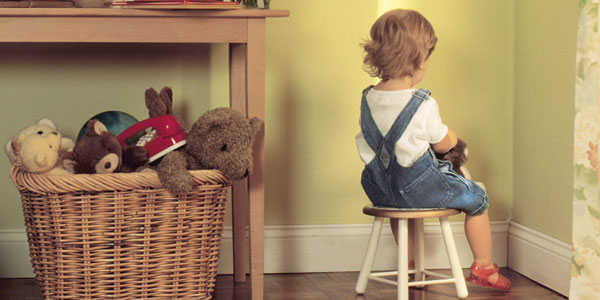
La penitencia al estilo tiempo fuera o “time out” es una popular disciplina utilizada para educar a los niños. El objetivo es disminuir el comportamiento inapropiado al eliminar al niño de una situación. Como por ejemplo, enviándolo a una esquina o al cuarto por un mal comportamiento. Pero el tiempo de espera sólo es efectivo si se incorporan los siguientes componentes clave:
* En primer lugar, el tiempo fuera debe calmar al niño: Cuando los adultos estamos enojados, a menudo hacemos algo para calmarnos, como tomar una ducha caliente o escuchar música. Entonces, ¿por qué esperamos que los niños se paren en un rincón o vayan a su cuarto y se calmen mágicamente?
Las habilidades para afrontar una situación son estrategias de vida que deben ser enseñadas. Por lo tanto, es importante proporcionar opciones calmantes durante el tiempo fuera. Como, por ejemplo, la respiración profunda, un libro, un animal de peluche, o crayones.
* Segundo, ceda el tiempo necesario para que el niño se calme: Algunos padres esperan que sus hijos permanezcan en silencio durante el tiempo fuera. Sin embargo esto puede enfadar aún más al niño. Al igual que con los adultos, los niños necesitan un lugar seguro para refrescarse y reagruparse. Es muy importante que el niño esté tranquilo cuando empiece a hablar acerca del problema.
* Finalmente, después de que el niño se calme, es importante discutir el comportamiento con él o ella: Este paso a menudo se pierde, aunque es el más importante de todos.
Discuta lo que sucedió y sus sentimientos, explique por qué el comportamiento fue inapropiado y qué debería hacer el niño la próxima vez que haya una situación similar. Los niños aprenden el comportamiento correcto, y si no le enseñamos cuál es el comportamiento correcto, es probable que el niño continúe con el comportamiento inapropiado.
___________________________________________________________________________________________________________
How to make time out effective
Commentary by Carey Juez-Perez, Licensed Clinical Social Worker
Time out is a popular form of discipline that’s used on children. The goal is to decrease inappropriate behavior by removing the child from a situation, such as by sending the child to a corner or to the child’s room for misbehavior. But time out is only effective if the following key components are incorporated:
*First, provide a calming strategy: When we adults are angry, we often do something to calm down, such as take a hot shower or listen to music. So why do we expect children to stand in a corner or go to their room and magically calm down?
Coping skills are lifelong strategies that must be taught. Therefore, provide calming options in time out, such as bubbles to take a deep breath, a book, a stuffed animal, crayons or a squishy ball.
*Second, allow the child time to calm down: Some parents expect their children to remain silent during time out. However, children are often angry and upset while in time out. As with adults, children need a safe place to cool off and regroup. It’s most important for the child to be calm when you begin talking through the problem.
*Finally, after the child calms down, discuss the behavior with him or her: This step is often missed, even though it’s the most important one.
Discuss what happened, feelings, why the behavior was inappropriate and what the child should do the next time there’s a similar situation. Because behavior is learned, if the child isn’t taught replacement behavior, the child is likely to continue the inappropriate behavior until taught otherwise.










